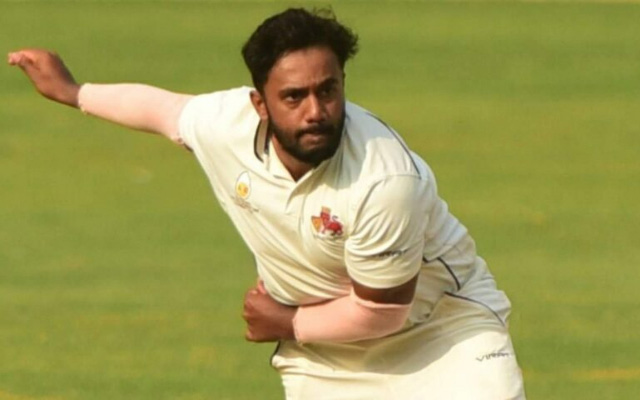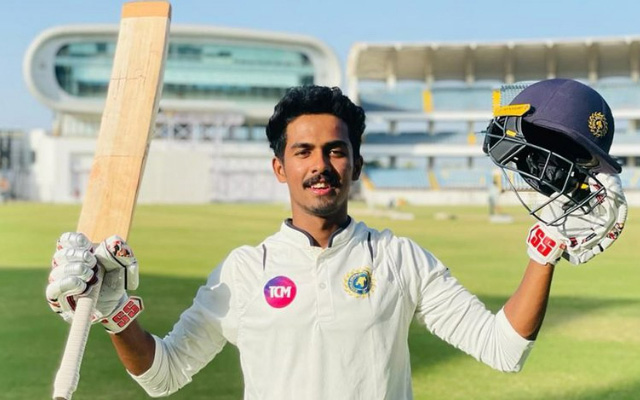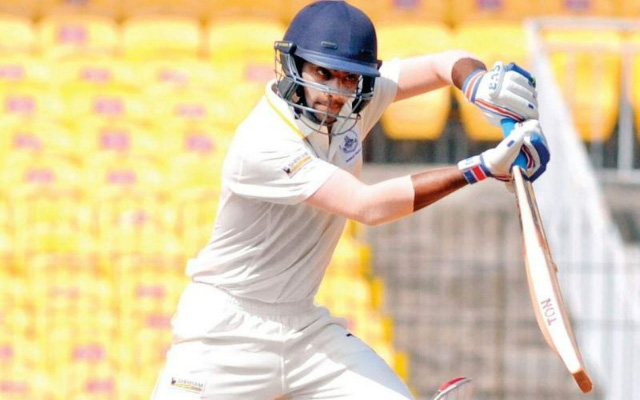Ranji Trophy 2021-22: Team of the tournament after group stage
Jharkhand are set to play a pre-quarter-final against Nagaland before moving to QF.
8 Min Read


Baba Indrajith (Photo source: Twitter)

The difficulties associated with staging the Ranji Trophy in a Covid-stricken calendar meant that it would be a changed format this time with each team getting to play three games only in the group stage, and only the winner going through from each group. Superlative performances abounded in the 57 games played, which makes it difficult to pick an XI of the best performers without leaving out other equally deserving names who miss out solely due to a lack of space.
Thus, special mentions are made for those whose efforts were equally, if not more, deserving enough to merit a place in the team. The XI has been picked on the players’ consistency throughout the tournament, the quality of opposition, the conditions in which they played, and the criticality of their efforts to their team’s performances.
Best XI of Ranji Trophy 2021-22 after group stage
Openers
Rohan Kunnummal (Kerala, four innings, 417 runs, average- 139.00)

It never seemed like the 23-year old was making his debut for Kerala in first-class cricket, with three back-to-back hundreds, he gave the impression of having been around for ages. His form was a major reason for the resilient displays of his team who were well on course for qualifying till their sudden, inexplicable collapse in the last session of the last day against Madhya Pradesh.
What was also very impressive to note was his strike rate of 89.66 in accumulating the runs, indicating the ease he has in playing his shots and dominating the bowlers. Finding a reliable opening pair has been Kerala’s Achilles heel in the past but now with Kunnummal’s emergence and the impressive performances of his opening partner Ponnan Rahul, the team can safely look to build their future around the solid pair.
Yash Dubey (Madhya Pradesh, four innings, 422 runs, average- 140.66)
Dubey played a mammoth inning of 289 against Kerala at Rajkot that ultimately decided the game in his team’s favor and led to their qualification from the group. He held one end with resoluteness and smashed out Kerala’s formidable bowling attack with ease. Like Kunnummal, he is undoubtedly one of the openers in the domestic circuit to watch out for and the ontinuance of the form he has shown in the first phase will be key for Madhya Pradesh’s aspirations this season.
Special mentions: Yash Dhull (Delhi, six innings, 479 runs, average- 119.75), Dhruv Shorey (Delhi, six innings, 383 runs, average- 76.60), Taruwar Kohli (Mizoram, six innings, 526 runs, average- 131.50).
Middle-order
Baba Indrajith (Tamil Nadu, four innings, 396 runs, average- 99.00)

While Tamil Nadu ultimately came up short in, what may be called the group of death, where they were pitted against the likes of Chhattisgarh, Delhi, and Jharkhand, some excellent batting performances were seen from their ends such as Shahrukh Khan’s blistering 194 against Delhi or Baba Aparajith’s refined 166 against Chhattisgarh. However, it was Baba Indrajith who stole the limelight by displaying remarkable consistency, scoring 50+ every time he took to the crease, including a hundred against each of the three teams. With a first-class average of 53.55, the talent was never in question, it was just a matter of finding that consistency, for which he seems to have made a start this season.
Het Patel (Gujarat, five innings, 429 runs, average- 85.80)
The Gujarat team had a disappointing outing this time, losing two out of three games, and it was majorly down to the failure of their top-order to get going. However, the young wicketkeeper Het Patel proved an exception and his best came against Kerala when he managed to score 185 runs. With the side looking for a replacement for the retired Parthiv Patel, Het’s phenomenal performance would be a major relief to the team management. His composure, resilience, and stroke-making ability could see him become a major lynchpin for Gujarat in the time to come.
Sarfaraz Khan (Mumbai, four innings, 551 runs, average- 137.75)
His penchant for scoring big was always visible since his school cricket days but the transition to the big stage, especially in red-ball cricket, hadn’t quite happened to his liking until the triple century he scored in the 2019-20 Ranji Trophy season. He carried off as if there had been no break all this while and his performances were instrumental in ensuring Mumbai’s qualification from a deceptively tough group.
His lowest score in the four innings he played was 48 and his highest of 275 came up against the defending champions Saurashtra. With a void opening up in India’s middle-order with the departure of Ajinkya Rahane and Cheteshwar Pujara, it would certainly not be a stretch to say that Sarfaraz should be one of the foremost names on the selectors’ radar in their search for replacements.
Mandeep Singh (Punjab, four innings, 358 runs, average- 179.00)
Punjab had strong competition in their group in the likes of Haryana and Himachal Pradesh, and it was Mandeep Singh’s prowess that seamlessly ensured their passage to the quarterfinals. His dominance on the side’s fortunes was evident from the fact that the second-most runs scored in the team were 167, less than half of the runs scored by Singh (27% of Punjab’s runs were scored by him). Continuing his form in the second half of the campaign may just see him pull himself into the reckoning for a spot in the Indian Test/’A’ team.
Special mentions: Sakibul Gani (Bihar, four innings, 601 runs, average- 150.25), Manish Pandey (Karnataka, 325 runs, average- 162.50), Sheldon Jackson (Saurashtra, 313 runs, average- 78.25).
Bowlers
Shams Mulani (Mumbai, six innings, 29 wickets, average- 15.62)

Mulani was easily the best Mumbai player in the group stages, chipping in with performances just when the team needed him the most. Against Goa, Mulani came in to bat when Mumbai were 198-6 in their second innings after conceding a 164 run first-innings lead and stitched a 116-run stand with Tanush Kotian for the eighth wicket that snatched the game from Goa’s jaws. The highest wicket-taker in the group stages, the left-arm orthodox spinner is surely the one to watch out for in the future, and Mumbai’s aspirations of lifting the Trophy after a hiatus will be majorly dependent on his ability to bowl the same way in the second phase of the tournament.
Jalaj Saxena (Kerala, four innings, 13 wickets, average- 19.76)
The flat tracks that offered no help in all three games he played didn’t stop the wily off-spinner from weaving his magic with the ball. Against Madhya Pradesh, at every point when his team seemed down and out of the do-or-die contest, Saxena kept pulling them back with wickets, scalping six of them in total and setting up the chase that Kerala almost managed to pull off. A consistent performer for close to eight seasons now, Saxena showed that the fire hasn’t diminished one bit and he really deserves the selection spotlight whenever Ravichandran Ashwin isn’t around or on occasions when there is a need for a second off-spinner.
Satyajeet Bachhav (Maharashtra, five innings, 21 wickets, average- 19.61)
Bachhav was a constant thorn in the flesh for the opposing sides and recorded two seven-wicket hauls in an innings- against Assam and Uttar Pradesh. He seems to be entering his prime now, having matured from his experiences playing league cricket in the United Kingdom and could be groomed further by being introduced into the India A setup.
T Ravi Teja (Hyderabad, six innings, 20 wickets, average- 14.95)
Hyderabad could not make it to the next round in a group where they were pitted against Bengal, Baroda, and Chandigarh, but still finished second majorly due to the efforts of their pace bowler Ravi Teja. Player of the match in two games out of three he played, his best performance of 6-41 came in the win against Chandigarh. Someone who has flown under the radar due to a lack of Indian Premier League (IPL) contract, can be one of the options to try on the next India A tour.
M Prasidh Krishna (Karnataka, six innings, 15 wickets, average- 11.60)
Krishna has done exceedingly well in recent times and he carried his good form into this season’s Ranji, taking a 10-wicket haul against Jammu and Kashmir, cutting through their batting in both innings with ease. With his displays, the lanky bowler has shown that he is equally at ease with the red ball, as much as he has been with the white ball.
Special mentions: Dharmendrasinh Jadeja (Saurashtra, 5 innings, 19 wickets, average- 24.31), Aditya Sarwate (Vidarbha, six innings, 17 wickets, average- 19.41), Baltej Singh (Punjab, six innings, 18 wickets, average- 15.00).
Download Our App